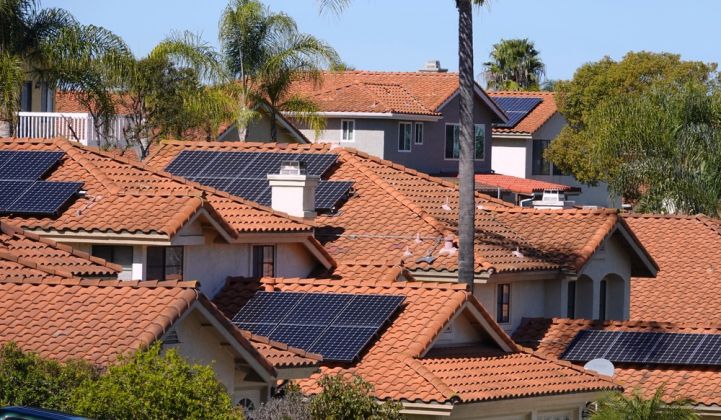A recent petition to the Federal Energy Regulatory Commission could trigger nationwide changes to solar net metering. On April 14, the New England Ratepayers Association (NERA) petitioned FERC to assert jurisdiction over any on-site, behind-the-meter generation that injects energy onto the grid.
If FERC asserts such jurisdiction in the manner requested by NERA, individual states could lose control over their solar net-metering policies — with myriad implications for the U.S. distributed solar market.
NERA’s net-metering petition
Today, states set their own rules for solar energy generated by residential, commercial and municipal utility customers in excess of what the customer needs at any given time. Over 40 states now require utilities to provide net-metering credits for that excess energy.
NERA believes most solar net-metering amounts to energy sales that should be subject to FERC’s jurisdiction, and that such sales should be priced at no more than a utility’s avoided costs rather than compensated at retail rates. NERA argues that net-metering generators are qualifying facilities (QFs) pursuant to the Public Utility Regulatory Policies Act (PURPA).
If FERC agrees, that could mean significantly less compensation for homes, businesses and municipalities that have invested in existing distributed solar systems and a decline in installations of new systems.
FERC has previously ruled that states have jurisdiction over the regulation of their own net metering, but NERA argues that FERC’s current policy was wrongly decided.
Potential impacts on solar markets
If states lose control over net metering and virtually all behind-the-meter solar systems come to be treated as QFs, the practical implications could be significant. Variables that could be impacted include the following:
- There would likely be a pause in development and a resulting drop in jobs and investment, at least until FERC and utilities figure out how to implement QF rules in the context of distributed solar and states redesign incentive programs.
- State net-metering programs could be rendered defunct. States where excess production is priced at the retail rate could start pricing at the purchasing utility’s avoided-cost rate, often 50 percent or lower by comparison.
- Distributed solar development may decrease in states with robust net-metering regimes (e.g., California, Massachusetts) but increase in states that have thus far resisted net metering (e.g., Tennessee, Alabama).
- Existing meters used for net metering may not measure real-time injection separately from real-time consumption. Solar system owners and many utilities could face significant data capture and tracking problems and may be forced to install additional equipment and increase investment. Each existing generator may need to buy and install a new meter approved by the local utility.
- States that want to regulate the amount of distributed solar would likely implement or enhance other incentives/disincentives such as revising renewable energy credit markets or reallocating the portion of electricity rates for delivery/infrastructure costs. Changes would likely take years to implement.
- Each interconnection customer, typically the host for distributed solar, would have to register with its independent system operator. Some would enter into PURPA-compliant contracts with utilities, while others would sell at real-time market rates. (Separately, FERC is proposing changes that would affect the price structures utilities provide to QFs, so it is uncertain what small generators’ filing requirements and price availability will be.)
- Generators with systems over 1 MW (AC) would have to self-certify with FERC and file updates for ownership changes.
- Filing obligations and availability of PURPA-compliant contracts would depend on the size of the system owned by the generator, and generators would need to beware of rules governing the aggregation of commonly owned systems located close together.
- Utilities and customers would have to adjust to the tax and financial reporting consequences of net-metering offsets becoming separate energy-sale transactions.
- Some utilities would experience an unplanned administrative burden and significant changes to rate-based cost structures, which could lead to reduced profits or to windfalls, depending on the circumstances for each utility.
Impacts unique to existing solar generators
Billions of dollars have been invested in distributed solar based on state net-metering policies. In addition to the implications discussed above, QF status would worsen the economics for most existing net-metered solar systems by removing the benefits they had expected when built.
System hosts will receive less compensation on net-metered power, which can often amount to 5 percent to 20 percent of their solar production. Electricity cost savings they relied on would be eroded, potentially costing jobs and hindering future economic investment.
Unless FERC creates an exception, existing solar systems would have to follow the new rules. While difficult to say how quickly new rules could be implemented, the rulemaking process may take years.
So will FERC issue the order?
Significant headwinds weigh against FERC changing its long-held precedent.
If FERC asserts jurisdiction over net-metering generators, it would likely wade into the murky waters (and likely litigation) of the proper allocation of power between states and the federal government and would increase its own administrative burden by overseeing a slew of distributed solar facilities currently regulated by states.
That said, FERC's recent minimum offer price rule decision demonstrates that the commissioners, all of whom are recent appointees, may have an expanded view of FERC’s authority and be willing to assert preemption over state rulemaking.
FERC is currently accepting comments and intervenors from individuals and organizations. The period to comment or intervene ends June 15, 2020.
***
Ben Huffman is a partner with law firm Sheppard Mullin's energy, infrastructure and project finance team. Marc Palmer is managing director of New Resource Solutions, a clean energy project facilitator.




